load capacity JEEP WRANGLER UNLIMITED 2021 Owner handbook (in English)
[x] Cancel search | Manufacturer: JEEP, Model Year: 2021, Model line: WRANGLER UNLIMITED, Model: JEEP WRANGLER UNLIMITED 2021Pages: 330, PDF Size: 9.16 MB
Page 36 of 330
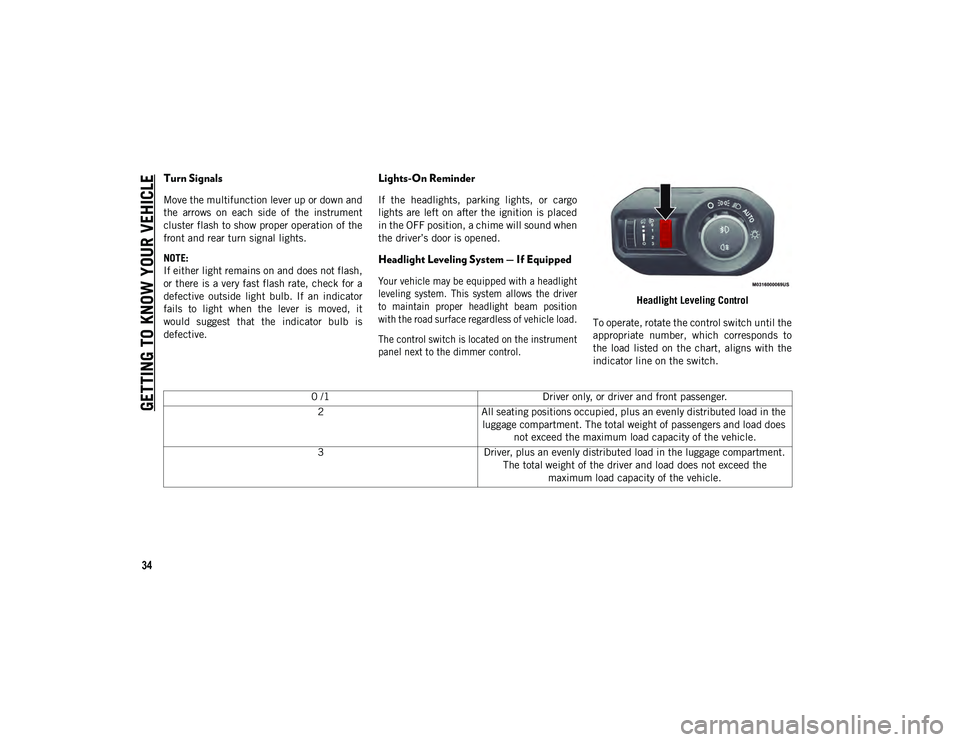
GETTING TO KNOW YOUR VEHICLE
34
Turn Signals
Move the multifunction lever up or down and
the arrows on each side of the instrument
cluster flash to show proper operation of the
front and rear turn signal lights.
NOTE:
If either light remains on and does not flash,
or there is a very fast flash rate, check for a
defective outside light bulb. If an indicator
fails to light when the lever is moved, it
would suggest that the indicator bulb is
defective.
Lights-On Reminder
If the headlights, parking lights, or cargo
lights are left on after the ignition is placed
in the OFF position, a chime will sound when
the driver’s door is opened.
Headlight Leveling System — If Equipped
Your vehicle may be equipped with a headlight
leveling system. This system allows the driver
to maintain proper headlight beam position
with the road surface regardless of vehicle load.
The control switch is located on the instrument
panel next to the dimmer control.
Headlight Leveling Control
To operate, rotate the control switch until the
appropriate number, which corresponds to
the load listed on the chart, aligns with the
indicator line on the switch.
0 /1 Driver only, or driver and front passenger.
2 All seating positions occupied, plus an evenly distributed load in the
luggage compartment. The total weight of passengers and load does not exceed the maximum load capacity of the vehicle.
3 Driver, plus an evenly distributed load in the luggage compartment.
The total weight of the driver and load does not exceed the maximum load capacity of the vehicle.
2020_JEEP_JL_WRANGLER_UG_RHD_UK.book Page 34
Page 60 of 330
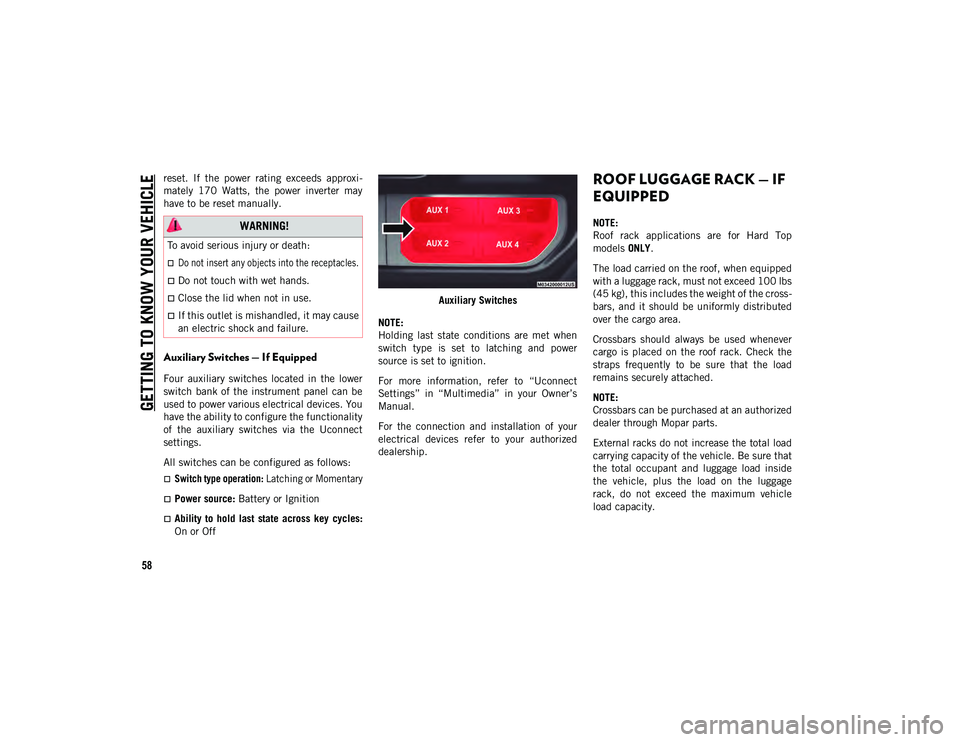
GETTING TO KNOW YOUR VEHICLE
58
reset. If the power rating exceeds approxi-
mately 170 Watts, the power inverter may
have to be reset manually.
Auxiliary Switches — If Equipped
Four auxiliary switches located in the lower
switch bank of the instrument panel can be
used to power various electrical devices. You
have the ability to configure the functionality
of the auxiliary switches via the Uconnect
settings.
All switches can be configured as follows:
Switch type operation: Latching or Momentary
Power source: Battery or Ignition
Ability to hold last state across key cycles:
On or Off Auxiliary Switches
NOTE:
Holding last state conditions are met when
switch type is set to latching and power
source is set to ignition.
For more information, refer to “Uconnect
Settings” in “Multimedia” in your Owner’s
Manual.
For the connection and installation of your
electrical devices refer to your authorized
dealership.
ROOF LUGGAGE RACK — IF
EQUIPPED
NOTE:
Roof rack applications are for Hard Top
models ONLY.
The load carried on the roof, when equipped
with a luggage rack, must not exceed 100 lbs
(45 kg), this includes the weight of the cross -
bars, and it should be uniformly distributed
over the cargo area.
Crossbars should always be used whenever
cargo is placed on the roof rack. Check the
straps frequently to be sure that the load
remains securely attached.
NOTE:
Crossbars can be purchased at an authorized
dealer through Mopar parts.
External racks do not increase the total load
carrying capacity of the vehicle. Be sure that
the total occupant and luggage load inside
the vehicle, plus the load on the luggage
rack, do not exceed the maximum vehicle
load capacity. WARNING!
To avoid serious injury or death:
Do not insert any objects into the receptacles.
Do not touch with wet hands.
Close the lid when not in use.
If this outlet is mishandled, it may cause
an electric shock and failure.
2020_JEEP_JL_WRANGLER_UG_RHD_UK.book Page 58
Page 61 of 330
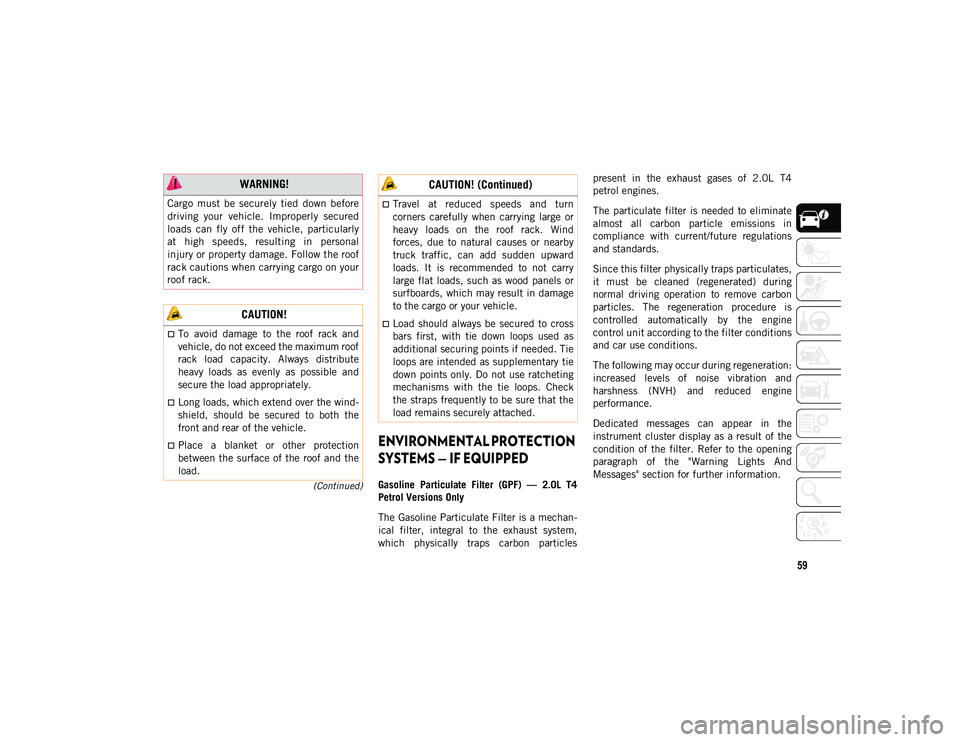
59
(Continued)
ENVIRONMENTAL PROTECTION
SYSTEMS — IF EQUIPPED
Gasoline Particulate Filter (GPF) — 2.0L T4
Petrol Versions Only
The Gasoline Particulate Filter is a mechan-
ical filter, integral to the exhaust system,
which physically traps carbon particles present in the exhaust gases of 2.0L T4
petrol engines.
The particulate filter is needed to eliminate
almost all carbon particle emissions in
compliance with current/future regulations
and standards.
Since this filter physically traps particulates,
it must be cleaned (regenerated) during
normal driving operation to remove carbon
particles. The regeneration procedure is
controlled automatically by the engine
control unit according to the filter conditions
and car use conditions.
The following may occur during regeneration:
increased levels of noise vibration and
harshness (NVH) and reduced engine
performance.
Dedicated messages can appear in the
instrument cluster display as a result of the
condition of the filter. Refer to the opening
paragraph of the "Warning Lights And
Messages" section for further information.
WARNING!
Cargo must be securely tied down before
driving your vehicle. Improperly secured
loads can fly off the vehicle, particularly
at high speeds, resulting in personal
injury or property damage. Follow the roof
rack cautions when carrying cargo on your
roof rack.
CAUTION!
To avoid damage to the roof rack and
vehicle, do not exceed the maximum roof
rack load capacity. Always distribute
heavy loads as evenly as possible and
secure the load appropriately.
Long loads, which extend over the wind
-
shield, should be secured to both the
front and rear of the vehicle.
Place a blanket or other protection
between the surface of the roof and the
load.
Travel at reduced speeds and turn
corners carefully when carrying large or
heavy loads on the roof rack. Wind
forces, due to natural causes or nearby
truck traffic, can add sudden upward
loads. It is recommended to not carry
large flat loads, such as wood panels or
surfboards, which may result in damage
to the cargo or your vehicle.
Load should always be secured to cross
bars first, with tie down loops used as
additional securing points if needed. Tie
loops are intended as supplementary tie
down points only. Do not use ratcheting
mechanisms with the tie loops. Check
the straps frequently to be sure that the
load remains securely attached.
CAUTION! (Continued)
2020_JEEP_JL_WRANGLER_UG_RHD_UK.book Page 59
Page 176 of 330
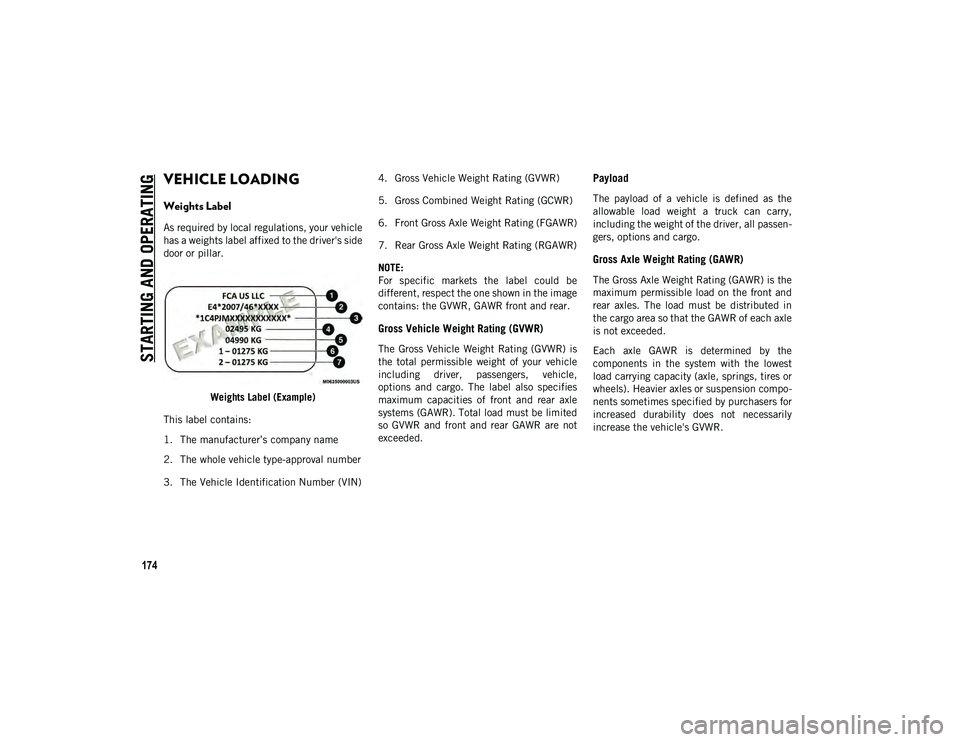
STARTING AND OPERATING
174
VEHICLE LOADING
Weights Label
As required by local regulations, your vehicle
has a weights label affixed to the driver's side
door or pillar.Weights Label (Example)
This label contains:
1. The manufacturer’s company name
2. The whole vehicle type-approval number
3. The Vehicle Identification Number (VIN) 4. Gross Vehicle Weight Rating (GVWR)
5. Gross Combined Weight Rating (GCWR)
6. Front Gross Axle Weight Rating (FGAWR)
7. Rear Gross Axle Weight Rating (RGAWR)
NOTE:
For specific markets the label could be
different, respect the one shown in the image
contains: the GVWR, GAWR front and rear.
Gross Vehicle Weight Rating (GVWR)
The Gross Vehicle Weight Rating (GVWR) is
the total permissible weight of your vehicle
including driver, passengers, vehicle,
options and cargo. The label also specifies
maximum capacities of front and rear axle
systems (GAWR). Total load must be limited
so GVWR and front and rear GAWR are not
exceeded.
Payload
The payload of a vehicle is defined as the
allowable load weight a truck can carry,
including the weight of the driver, all passen
-
gers, options and cargo.
Gross Axle Weight Rating (GAWR)
The Gross Axle Weight Rating (GAWR) is the
maximum permissible load on the front and
rear axles. The load must be distributed in
the cargo area so that the GAWR of each axle
is not exceeded.
Each axle GAWR is determined by the
components in the system with the lowest
load carrying capacity (axle, springs, tires or
wheels). Heavier axles or suspension compo -
nents sometimes specified by purchasers for
increased durability does not necessarily
increase the vehicle's GVWR.
2020_JEEP_JL_WRANGLER_UG_RHD_UK.book Page 174
Page 177 of 330
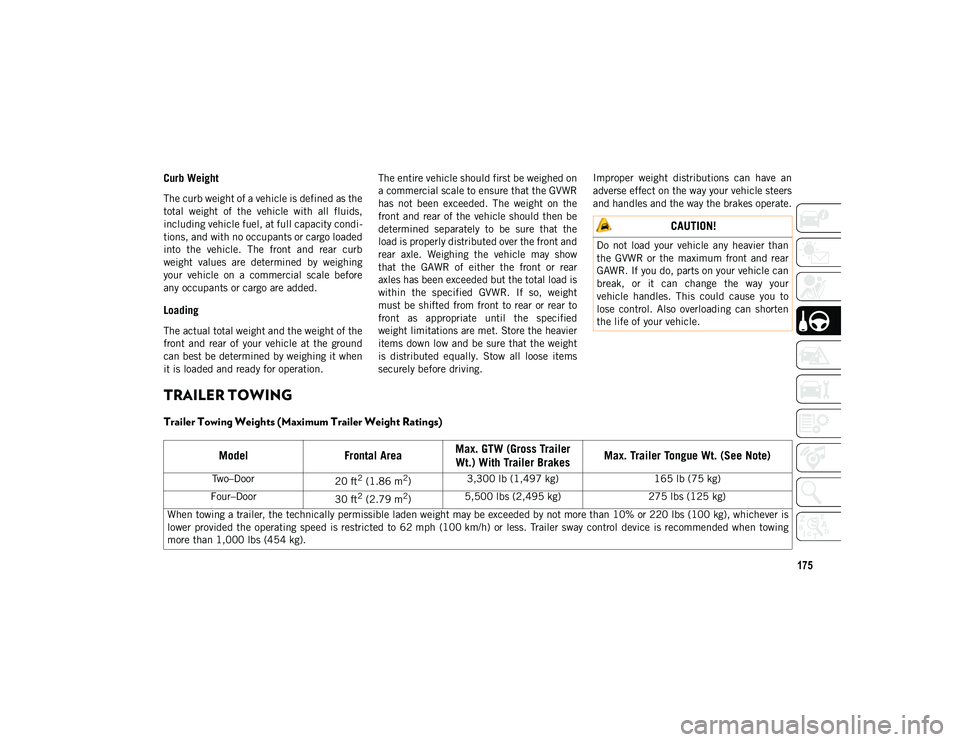
175
Curb Weight
The curb weight of a vehicle is defined as the
total weight of the vehicle with all fluids,
including vehicle fuel, at full capacity condi-
tions, and with no occupants or cargo loaded
into the vehicle. The front and rear curb
weight values are determined by weighing
your vehicle on a commercial scale before
any occupants or cargo are added.
Loading
The actual total weight and the weight of the
front and rear of your vehicle at the ground
can best be determined by weighing it when
it is loaded and ready for operation. The entire vehicle should first be weighed on
a commercial scale to ensure that the GVWR
has not been exceeded. The weight on the
front and rear of the vehicle should then be
determined separately to be sure that the
load is properly distributed over the front and
rear axle. Weighing the vehicle may show
that the GAWR of either the front or rear
axles has been exceeded but the total load is
within the specified GVWR. If so, weight
must be shifted from front to rear or rear to
front as appropriate until the specified
weight limitations are met. Store the heavier
items down low and be sure that the weight
is distributed equally. Stow all loose items
securely before driving.Improper weight distributions can have an
adverse effect on the way your vehicle steers
and handles and the way the brakes operate.
TRAILER TOWING
Trailer Towing Weights (Maximum Trailer Weight Ratings)
CAUTION!
Do not load your vehicle any heavier than
the GVWR or the maximum front and rear
GAWR. If you do, parts on your vehicle can
break, or it can change the way your
vehicle handles. This could cause you to
lose control. Also overloading can shorten
the life of your vehicle.
Model
Frontal AreaMax. GTW (Gross Trailer
Wt.) With Trailer Brakes Max. Trailer Tongue Wt. (See Note)
Two–Door
20 ft2 (1.86 m2)3,300 lb (1,497 kg)
165 lb (75 kg)
Four–Door 30 ft
2 (2.79 m2)5,500 lbs (2,495 kg)
275 lbs (125 kg)
When towing a trailer, the technically permissible laden weight may be exceeded by not more than 10% or 220 lbs (100 kg), whichever is
lower provided the operating speed is restricted to 62 mph (100 km/h) or less. Trailer sway control device is recommended when towing
more than 1,000 lbs (454 kg).
2020_JEEP_JL_WRANGLER_UG_RHD_UK.book Page 175
Page 236 of 330
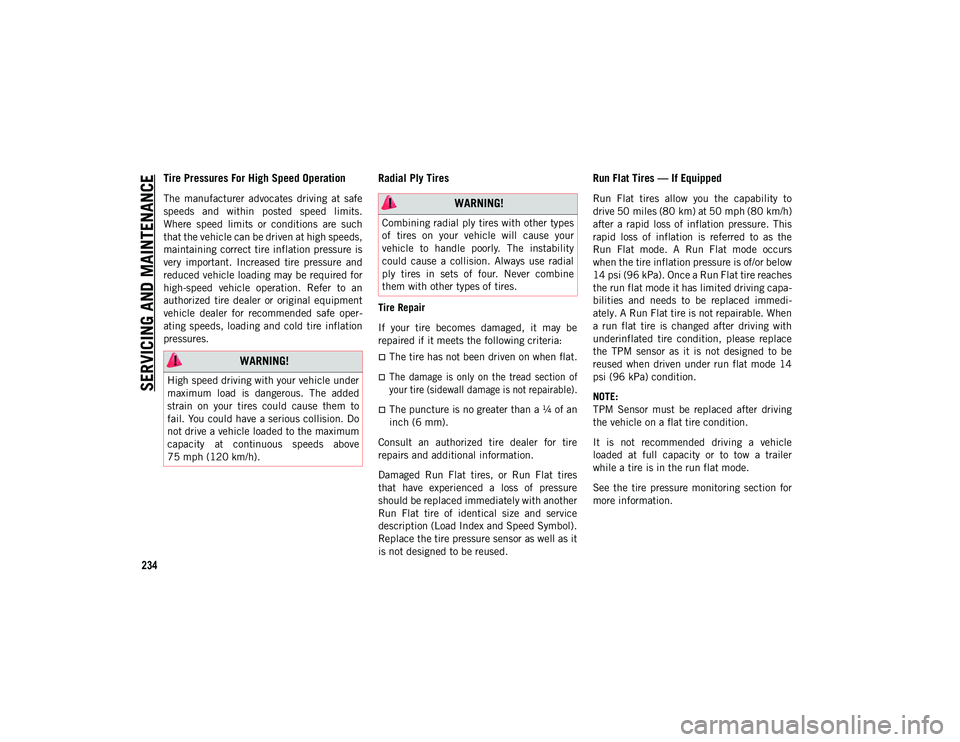
SERVICING AND MAINTENANCE
234
Tire Pressures For High Speed Operation
The manufacturer advocates driving at safe
speeds and within posted speed limits.
Where speed limits or conditions are such
that the vehicle can be driven at high speeds,
maintaining correct tire inflation pressure is
very important. Increased tire pressure and
reduced vehicle loading may be required for
high-speed vehicle operation. Refer to an
authorized tire dealer or original equipment
vehicle dealer for recommended safe oper-
ating speeds, loading and cold tire inflation
pressures.
Radial Ply Tires
Tire Repair
If your tire becomes damaged, it may be
repaired if it meets the following criteria:
The tire has not been driven on when flat.
The damage is only on the tread section of
your tire (sidewall damage is not repairable).
The puncture is no greater than a ¼ of an
inch (6 mm).
Consult an authorized tire dealer for tire
repairs and additional information.
Damaged Run Flat tires, or Run Flat tires
that have experienced a loss of pressure
should be replaced immediately with another
Run Flat tire of identical size and service
description (Load Index and Speed Symbol).
Replace the tire pressure sensor as well as it
is not designed to be reused.
Run Flat Tires — If Equipped
Run Flat tires allow you the capability to
drive 50 miles (80 km) at 50 mph (80 km/h)
after a rapid loss of inflation pressure. This
rapid loss of inflation is referred to as the
Run Flat mode. A Run Flat mode occurs
when the tire inflation pressure is of/or below
14 psi (96 kPa). Once a Run Flat tire reaches
the run flat mode it has limited driving capa -
bilities and needs to be replaced immedi -
ately. A Run Flat tire is not repairable. When
a run flat tire is changed after driving with
underinflated tire condition, please replace
the TPM sensor as it is not designed to be
reused when driven under run flat mode 14
psi (96 kPa) condition.
NOTE:
TPM Sensor must be replaced after driving
the vehicle on a flat tire condition.
It is not recommended driving a vehicle
loaded at full capacity or to tow a trailer
while a tire is in the run flat mode.
See the tire pressure monitoring section for
more information.
WARNING!
High speed driving with your vehicle under
maximum load is dangerous. The added
strain on your tires could cause them to
fail. You could have a serious collision. Do
not drive a vehicle loaded to the maximum
capacity at continuous speeds above
75 mph (120 km/h).
WARNING!
Combining radial ply tires with other types
of tires on your vehicle will cause your
vehicle to handle poorly. The instability
could cause a collision. Always use radial
ply tires in sets of four. Never combine
them with other types of tires.
2020_JEEP_JL_WRANGLER_UG_RHD_UK.book Page 234
Page 238 of 330
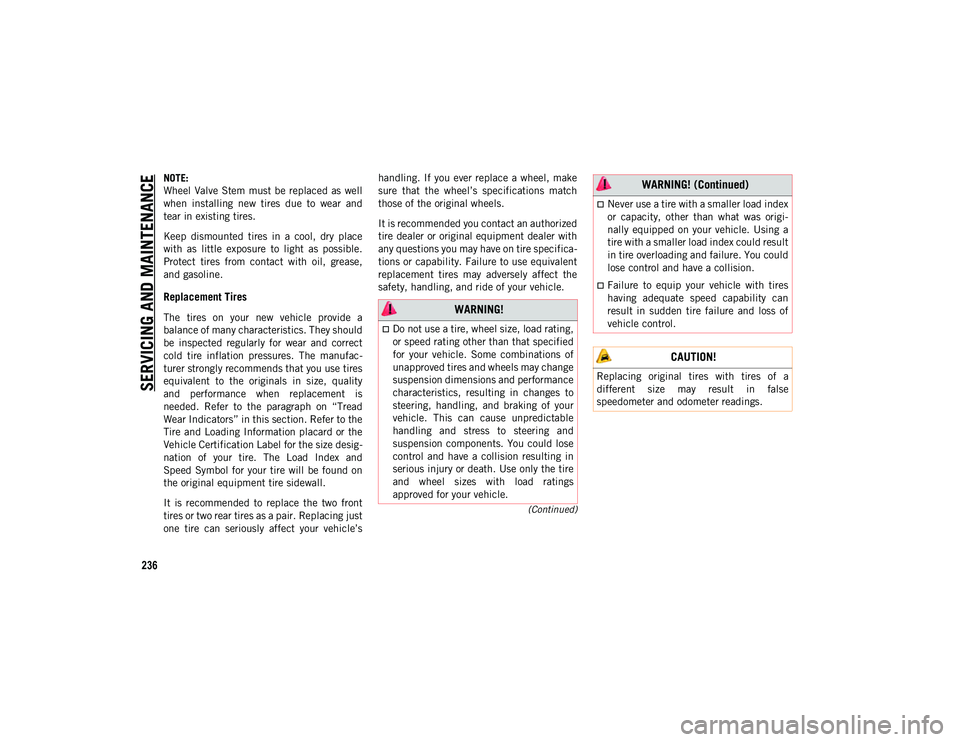
SERVICING AND MAINTENANCE
236
(Continued)
NOTE:
Wheel Valve Stem must be replaced as well
when installing new tires due to wear and
tear in existing tires.
Keep dismounted tires in a cool, dry place
with as little exposure to light as possible.
Protect tires from contact with oil, grease,
and gasoline.
Replacement Tires
The tires on your new vehicle provide a
balance of many characteristics. They should
be inspected regularly for wear and correct
cold tire inflation pressures. The manufac-
turer strongly recommends that you use tires
equivalent to the originals in size, quality
and performance when replacement is
needed. Refer to the paragraph on “Tread
Wear Indicators” in this section. Refer to the
Tire and Loading Information placard or the
Vehicle Certification Label for the size desig -
nation of your tire. The Load Index and
Speed Symbol for your tire will be found on
the original equipment tire sidewall.
It is recommended to replace the two front
tires or two rear tires as a pair. Replacing just
one tire can seriously affect your vehicle’s handling. If you ever replace a wheel, make
sure that the wheel’s specifications match
those of the original wheels.
It is recommended you contact an authorized
tire dealer or original equipment dealer with
any questions you may have on tire specifica
-
tions or capability. Failure to use equivalent
replacement tires may adversely affect the
safety, handling, and ride of your vehicle. WARNING!
Do not use a tire, wheel size, load rating,
or speed rating other than that specified
for your vehicle. Some combinations of
unapproved tires and wheels may change
suspension dimensions and performance
characteristics, resulting in changes to
steering, handling, and braking of your
vehicle. This can cause unpredictable
handling and stress to steering and
suspension components. You could lose
control and have a collision resulting in
serious injury or death. Use only the tire
and wheel sizes with load ratings
approved for your vehicle.
Never use a tire with a smaller load index
or capacity, other than what was origi -
nally equipped on your vehicle. Using a
tire with a smaller load index could result
in tire overloading and failure. You could
lose control and have a collision.
Failure to equip your vehicle with tires
having adequate speed capability can
result in sudden tire failure and loss of
vehicle control.
CAUTION!
Replacing original tires with tires of a
different size may result in false
speedometer and odometer readings.
WARNING! (Continued)
2020_JEEP_JL_WRANGLER_UG_RHD_UK.book Page 236
Page 325 of 330
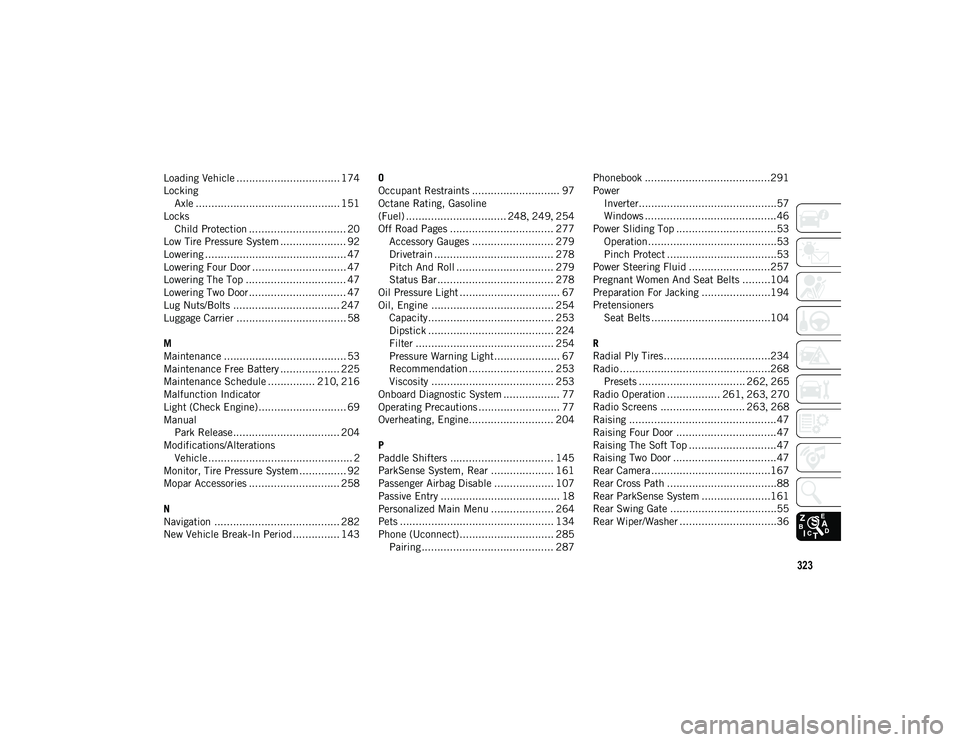
323
Loading Vehicle ................................. 174
LockingAxle .............................................. 151
Locks Child Protection ............................... 20
Low Tire Pressure System ..................... 92
Lowering ............................................. 47
Lowering Four Door .............................. 47
Lowering The Top ................................ 47
Lowering Two Door ............................... 47
Lug Nuts/Bolts .................................. 247
Luggage Carrier ................................... 58
M
Maintenance ....................................... 53
Maintenance Free Battery ................... 225
Maintenance Schedule ............... 210 , 216
Malfunction Indicator
Light (Check Engine)............................ 69
Manual Park Release.................................. 204
Modifications/Alterations Vehicle .............................................. 2
Monitor, Tire Pressure System ............... 92
Mopar Accessories ............................. 258
N
Navigation ........................................ 282
New Vehicle Break-In Period ............... 143 O
Occupant Restraints ............................ 97
Octane Rating, Gasoline
(Fuel) ................................ 248
, 249 , 254
Off Road Pages ................................. 277 Accessory Gauges .......................... 279
Drivetrain ...................................... 278
Pitch And Roll ............................... 279
Status Bar ..................................... 278
Oil Pressure Light ................................ 67
Oil, Engine ....................................... 254 Capacity........................................ 253
Dipstick ........................................ 224
Filter ............................................ 254
Pressure Warning Light..................... 67Recommendation ........................... 253
Viscosity ....................................... 253
Onboard Diagnostic System .................. 77
Operating Precautions .......................... 77
Overheating, Engine........................... 204
P
Paddle Shifters ................................. 145
ParkSense System, Rear .................... 161
Passenger Airbag Disable ................... 107
Passive Entry ...................................... 18
Personalized Main Menu .................... 264
Pets ................................................. 134
Phone (Uconnect).............................. 285 Pairing .......................................... 287 Phonebook ........................................291
Power
Inverter............................................57Windows ..........................................46
Power Sliding Top ................................53 Operation.........................................53
Pinch Protect ...................................53
Power Steering Fluid ..........................257
Pregnant Women And Seat Belts .........104
Preparation For Jacking ......................194
Pretensioners Seat Belts ......................................104
R
Radial Ply Tires..................................234
Radio ................................................268 Presets .................................. 262 , 265
Radio Operation ................. 261 , 263 , 270
Radio Screens ........................... 263 , 268
Raising ...............................................47
Raising Four Door ................................47
Raising The Soft Top ............................47
Raising Two Door .................................47
Rear Camera......................................167
Rear Cross Path ...................................88
Rear ParkSense System ......................161
Rear Swing Gate ..................................55
Rear Wiper/Washer ...............................36
2020_JEEP_JL_WRANGLER_UG_RHD_UK.book Page 323